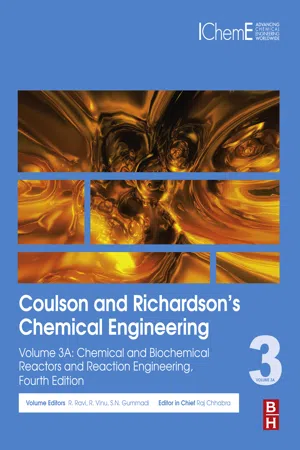
eBook - ePub
Coulson and Richardson's Chemical Engineering
Volume 3A: Chemical and Biochemical Reactors and Reaction Engineering
- 596 pages
- English
- ePUB (mobile friendly)
- Available on iOS & Android
eBook - ePub
Coulson and Richardson's Chemical Engineering
Volume 3A: Chemical and Biochemical Reactors and Reaction Engineering
About this book
Coulson and Richardson's Chemical Engineering: Volume 3A: Chemical and Biochemical Reactors and Reaction Engineering, Fourth Edition, covers reactor design, flow modelling, gas-liquid and gas-solid reactions and reactors.- Captures content converted from textbooks into fully revised reference material- Includes content ranging from foundational through technical- Features emerging applications, numerical methods and computational tools
Frequently asked questions
Yes, you can cancel anytime from the Subscription tab in your account settings on the Perlego website. Your subscription will stay active until the end of your current billing period. Learn how to cancel your subscription.
No, books cannot be downloaded as external files, such as PDFs, for use outside of Perlego. However, you can download books within the Perlego app for offline reading on mobile or tablet. Learn more here.
Perlego offers two plans: Essential and Complete
- Essential is ideal for learners and professionals who enjoy exploring a wide range of subjects. Access the Essential Library with 800,000+ trusted titles and best-sellers across business, personal growth, and the humanities. Includes unlimited reading time and Standard Read Aloud voice.
- Complete: Perfect for advanced learners and researchers needing full, unrestricted access. Unlock 1.4M+ books across hundreds of subjects, including academic and specialized titles. The Complete Plan also includes advanced features like Premium Read Aloud and Research Assistant.
We are an online textbook subscription service, where you can get access to an entire online library for less than the price of a single book per month. With over 1 million books across 1000+ topics, we’ve got you covered! Learn more here.
Look out for the read-aloud symbol on your next book to see if you can listen to it. The read-aloud tool reads text aloud for you, highlighting the text as it is being read. You can pause it, speed it up and slow it down. Learn more here.
Yes! You can use the Perlego app on both iOS or Android devices to read anytime, anywhere — even offline. Perfect for commutes or when you’re on the go.
Please note we cannot support devices running on iOS 13 and Android 7 or earlier. Learn more about using the app.
Please note we cannot support devices running on iOS 13 and Android 7 or earlier. Learn more about using the app.
Yes, you can access Coulson and Richardson's Chemical Engineering by R. Ravi,R. Vinu,S. N. Gummadi in PDF and/or ePUB format, as well as other popular books in Technology & Engineering & Chemical & Biochemical Engineering. We have over one million books available in our catalogue for you to explore.
Information
Edition
4Chapter 1
Reactor Design—General Principles
Ramamurthy Ravi Indian Institute of Technology Madras, Chennai, India
Abstract
A brief introduction to the basic objectives of reactor design and the various types of reactors used in the chemical industry is given. Material and energy balances are discussed from a fundamental viewpoint, and the specializing conditions leading to the simplified equations directly useful for reactor design are made clear. Kinetics, a crucial input to reactor design, is dealt with in some detail with examples of rate equations and how to obtain them from a given mechanism. Special attention is given to obtaining the kinetics from batch reactor data. A systematic derivation of the design equations of the ideal reactors—batch reactor, plug flow reactor, and continuous stirred tank reactor—is provided. Both isothermal and nonisothermal cases as well as liquid-phase and gas-phase reactions are analyzed. Examples are provided to illustrate the application of the equations. The chapter ends with a study of multiple reactions, both series and parallel, in ideal reactors.
Keywords
Batch reactor; Continuous stirred tank reactor; Design; Kinetics; Plug flow reactor
Learning Outcomes
1. The basic objectives of reactor design, classification of reactors, and guidelines for choice of process conditions (Sections 1.1–1.3).
2. The principles of material and energy balances, steady-state and unsteady-state cases, as well as integral and differential balance equations (Section 1.4).
3. The most common forms of rate equations (kinetics) and how to obtain them from a given mechanism (Section 1.5).
4. Derivation of design equations for a batch reactor and application of t...
Table of contents
- Cover image
- Title page
- Table of Contents
- Coulson & Richardson's Chemical Engineering
- Copyright
- List of Contributors
- About Prof. Coulson
- About Prof. Richardson
- Preface
- Introduction
- Chapter 1. Reactor Design—General Principles
- Chapter 2. Flow Characteristics of Reactors—Flow Modeling
- Chapter 3. Gas–Solid Reactions and Reactors
- Chapter 4. Gas–Liquid and Gas–Liquid–Solid Reactors
- Chapter 5. Fundamentals of Biological Sciences
- Chapter 6. Biochemical Reaction Engineering
- Index